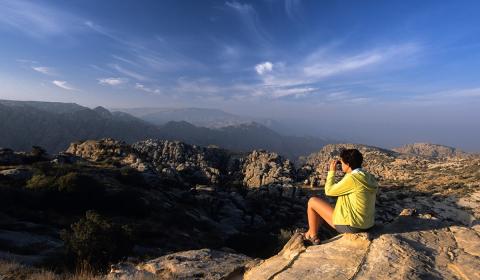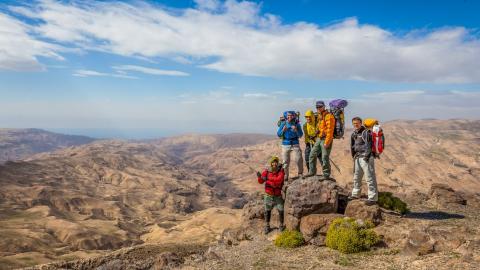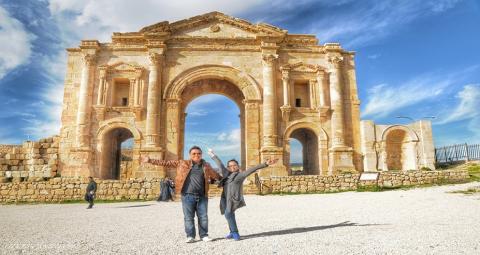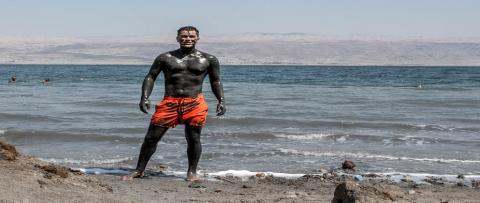Food in a Daily Life
An ancient legend tells of an Arabian shepherd who six thousand years ago put his supply of milk in a pouch made from a sheep's stomach before making a journey across the desert. The rennet in the lining of the pouch, combined with the heat of the sun, caused the milk to form curds, and cheese was discovered. Bedouin farmers keep herds of goats and sheep whose milk is used to produce cheese and yogurt. A popular cheese is called halloumi (similar to feta), made from goat or sheep milk and often served in a sandwich of pita-style bread or cubed in salads. Rice, legumes, olives, yogurt, flat breads, vegetables (cauliflower, eggplant, potatoes, okra, tomatoes, and cucumbers), lamb or chicken, and fruits (apricots, apples, bananas, melons, and oranges) form the basis for most meals. Main dishes of rice with spices are eaten almost daily. Breakfast usually includes a variety of white cheeses, olives, pickled vegetables, and freshly baked breads. The main meal typically is served during the middle of the afternoon. A covering is placed on the floor, with a large tray of rice and meat placed in the center surrounded by small dishes of yogurt and salad. Torn pieces of bread are folded in half and used to scoop the food. Dinner is generally a smaller meal than lunch and is usually a type of soup or the leftovers from lunch. As a note, the left hand is never used to feed oneself.
Mezze
By far the most dominant style of eating in Jordan, mezze is the small plate, salad, appetizer, community style eating, aided by dipping, chunking and otherwise scooping with bread. Mezze plates are typically rolled out before larger main dishes, but you’ll find that they will easily fill you up by themselves and leave you wondering, “Now why are they bringing out those mains?”
Hummus: Chick peas boiled and blended to perfect smoothness with tahini paste, garlic, olive oil, lemon juice.
Kubbeh: Herbed, minced meat covered in a crust of bulgur (crushed wheat), then fried.
Falafel: Those delightful little balls of fried chickpea flour and the best of Middle Eastern spice. Eat them on their own, dip them in every mezze.
Tabouleh: A salad of finely chopped parsley and mint turned with bulgur, tomatoes, onion and seasoned with olive oil and lemon juice.
Fattoush: Chopped vegetable salad (e.g., tomatoes, cucumbers, radish, etc.) tossed with pieces of dry or fried flatbread and seasoned with olive oil, lemon juice and sumac.
Labaneh: Creamy yogurt, so thick you can spread it on your flat bread and make a sandwich. Becomes rather addictive, especially with za’atar and olive oil in the morning for breakfast.
Moutabel: Roasted, pureed eggplant with garlic.
Makdous: Stuffed pickled eggplant.
Zetun: Olive salad cut with carrots, green pepper, chili, and olive oil.
Foul: Crushed fava beans served with a variety of toppings such as olive oil, lemon juice, parsley, chili pepper, and sumac.
Manakesh: Flatbread dough usually topped with and an olive oil and za’atar blend. Other varieties may include cheese or ground meat.
Bread
Kubz: Literally, “ordinary” bread. Bread with pockets.
Shrak: Traditional Jordanian bread thrown to great thinness before being tossed onto a hot iron griddle that’s shaped like an inverted wok.
Arboud: A dense, unleavened Bedouin bread baked directly in a wood fire by burying in ash and covering with hot embers.
Main Dishes
Mansaf: Jordan prides itself with the famous national dish of Mansaf. Mansaf is basically a meal of rice, lamb and aged yogurt that is made into balls and kept all year long called Jameed. The best kind of Jameed is the one that comes from the city of Karak in Jordan. Although Mansaf is a meal that is still prepared in the Bedouin culture, it has crossed the borders and became the national dish for Jordan. It is a crowd pleaser and a very satisfying meal. Mansaf is served on special occasions such as weddings and births, or to honor a guest, and of course on main holidays. It is traditionally eaten collectively from a large platter in the Bedouin style, standing around the platter with the left hand behind the back and using the right hand instead of utensils.
Maqluba: This perfect meal features all four food groups. It is inspired by the Arabic dish called 'Maqluba,' which translates to 'upside down.' When the meal has finished cooking, you take the pot and flip it upside down onto a large serving platter, and everybody helps themselves. This main dish has countless variations in ingredients, measurements and technique. The basic method is this: a large cooking pot is layered with meat or chicken, vegetables and rice; it’s cooked on the stove and flipped upside-down onto a large platter and served with yogurt on the side.
Kofta: Kofta is a food which is made by grinding beef or lamb and mixing it with an assortment of spices such as garlic, onions, cumin, coriander, cinnamon and turmeric. The resulting seasoned meat can be shaped into meatballs or cylinders of meat which can be cooked in a wide variety of ways. The two most common kofta dishes are kofta b'tahhini baked in a sea of tahini, topped with thinly sliced potatoes and pine nuts and served with rice or kofta b'bandoora baked in tomato sauce and served with rice.
Dolma / Dawali: In Western countries, it’s equivalent to stuffed cabbage roll. Traditionally, it is made from soft grape leaves stuffed with rice, minced meat and spices and then wrapped up tight in into a pouch. Perfect for popping into your mouth.. When it has meat, the dolma is served warm. When it is purely for herbivores, the dolma is served cold. Either way, it’s great with yogurt.
Zarb (Bedouin BBQ): Meat and vegetables slow-cooked in an underground pit until succulent. A typical zarb consists of chicken pieces blackened to crispy perfection with juice-dribbling perfect meat, baked potatoes, and whole onions cooked in their skins so that they’re melt-in-the-mouth creamy inside. It’s as much an experience to watch the barbecue rack being exhumed from the ground as it is to eat its contents!




